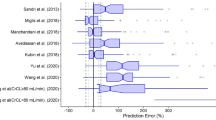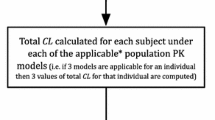Abstract
Objectives
Patients with hematological malignancies are prone to invasive fungal disease due to long-term chemotherapy or radiotherapy. Voriconazole is a second-generation triazole broad-spectrum antibiotic used to prevent or treat invasive fungal infections. Many population pharmacokinetic (pop PK) models have been published for voriconazole, and various diagnostic methods are available to validate the performance of these pop PK models. However, most of the published models have not been strictly evaluated externally. The purpose of this study is to evaluate these models externally and assess their predictive capabilities.
Methods
The external dataset consists of adults receiving voriconazole treatment at Fujian Medical University Union Hospital. We re-established the published models based on their final estimated values in the literature and used our external dataset for initial screening. Each model was evaluated based on the following outcomes: prediction-based diagnostics, prediction- and variability-corrected visual predictive check (pvcVPC), normalized prediction distribution errors (NPDE), and Bayesian simulation results with one to two prior observations.
Results
A total of 237 samples from 166 patients were collected as an external dataset. After screening, six candidate models suitable for the external dataset were finally obtained for comparison. Among the models, none demonstrated excellent predictive performance. Bayesian simulation shows that all models’ prediction precision and accuracy were significantly improved when one or two prior concentrations were given.
Conclusions
The published pop PK models of voriconazole have significant differences in prediction performance, and none of the models could perfectly predict the concentrations of voriconazole for our data. Therefore, extensive evaluation should precede the adoption of any model in clinical practice.



Similar content being viewed by others
Data availability
All data included in this study will be available upon request from the corresponding author.
References
Karlsson MO, Lutsar I, Milligan PA (2009) Population pharmacokinetic analysis of voriconazole plasma concentration data from pediatric studies. Antimicrob Agents Chemother 53(3):935–944. https://doi.org/10.1128/AAC.00751-08
Patterson TF, Thompson GR 3rd, Denning DW et al (2016) Practice guidelines for the diagnosis and management of aspergillosis: 2016 update by the Infectious Diseases Society of America. Clin Infect Dis 63(4):e1–e60. https://doi.org/10.1093/cid/ciw326
Dolton MJ, McLachlan AJ (2014) Voriconazole pharmacokinetics and exposure-response relationships: assessing the links between exposure, efficacy and toxicity. Int J Antimicrob Agents 44(3):183–193. https://doi.org/10.1016/j.ijantimicag.2014.05.019
Pascual A, Csajka C, Buclin T et al (2012) Challenging recommended oral and intravenous voriconazole doses for improved efficacy and safety: population pharmacokinetics-based analysis of adult patients with invasive fungal infections. Clin Infect Dis 55(3):381–390. https://doi.org/10.1093/cid/cis437
Ullmann AJ, Aguado JM, Arikan-Akdagli S et al (2018) Diagnosis and management of Aspergillus diseases: executive summary of the 2017 ESCMID-ECMM-ERS guideline. Clin Microbiol Infect 24(Suppl 1):e1–e38. https://doi.org/10.1016/j.cmi.2018.01.002
Chinese Association H, Working CIFI, G, (2020) The Chinese guidelines for the diagnosis and treatment of invasive fungal disease in patients with hematological disorders and cancers (the 6th revision). Zhonghua Nei Ke Za Zhi 59(10):754–763. https://doi.org/10.3760/cma.j.cn112138-20200627-00624
Ren QX, Li XG, Mu JS et al (2019) Population pharmacokinetics of voriconazole and optimization of dosage regimens based on Monte Carlo simulation in patients with liver cirrhosis. J Pharm Sci 108(12):3923–3931. https://doi.org/10.1016/j.xphs.2019.09.019
Gastine S, Lehrnbecher T, Muller C et al (2018) Pharmacokinetic modeling of voriconazole to develop an alternative dosing regimen in children. Antimicrob Agents Chemother 62(1). https://doi.org/10.1128/AAC.01194-17
Mangal N, Hamadeh IS, Arwood MJ et al (2018) Optimization of voriconazole therapy for the treatment of invasive fungal infections in adults. Clin Pharmacol Ther 104(5):957–965. https://doi.org/10.1002/cpt.1012
Scholz I, Oberwittler H, Riedel KD et al (2009) Pharmacokinetics, metabolism and bioavailability of the triazole antifungal agent voriconazole in relation to CYP2C19 genotype. Br J Clin Pharmacol 68(6):906–915. https://doi.org/10.1111/j.1365-2125.2009.03534.x
Mikus G, Schowel V, Drzewinska M et al (2006) Potent cytochrome P450 2C19 genotype-related interaction between voriconazole and the cytochrome P450 3A4 inhibitor ritonavir. Clin Pharmacol Ther 80(2):126–135. https://doi.org/10.1016/j.clpt.2006.04.004
Rengelshausen J, Banfield M, Riedel KD et al (2005) Opposite effects of short-term and long-term St John’s wort intake on voriconazole pharmacokinetics. Clin Pharmacol Ther 78(1):25–33. https://doi.org/10.1016/j.clpt.2005.01.024
Yan M, Wu ZF, Tang D et al (2018) The impact of proton pump inhibitors on the pharmacokinetics of voriconazole in vitro and in vivo. Biomed Pharmacother 108:60–64. https://doi.org/10.1016/j.biopha.2018.08.121
Johnson LB, Kauffman CA (2003) Voriconazole: a new triazole antifungal agent. Clin Infect Dis 36(5):630–637. https://doi.org/10.1086/367933
Tang D, Yan M, Song BL et al (2021) Population pharmacokinetics, safety and dosing optimization of voriconazole in patients with liver dysfunction: a prospective observational study. Br J Clin Pharmacol 87(4):1890–1902. https://doi.org/10.1111/bcp.14578
Friberg LE, Ravva P, Karlsson MO et al (2012) Integrated population pharmacokinetic analysis of voriconazole in children, adolescents, and adults. Antimicrob Agents Chemother 56(6):3032–3042. https://doi.org/10.1128/AAC.05761-11
Dolton MJ, McLachlan AJ (2014) Optimizing azole antifungal therapy in the prophylaxis and treatment of fungal infections. Curr Opin Infect Dis 27(6):493–500. https://doi.org/10.1097/QCO.0000000000000103
Liu Y, Qiu T, Liu Y et al (2019) Model-based voriconazole dose optimization in Chinese adult patients with hematologic malignancies. Clin Ther 41(6):1151–1163. https://doi.org/10.1016/j.clinthera.2019.04.027
Hope W, Johnstone G, Cicconi S et al (2019) Software for dosage individualization of voriconazole: a prospective clinical study. Antimicrob Agents Chemother 63(4). https://doi.org/10.1128/AAC.02353-18
Chaudhri K, Stocker SL, Williams KM et al (2020) Voriconazole: an audit of hospital-based dosing and monitoring and evaluation of the predictive performance of a dose-prediction software package. J Antimicrob Chemother 75(7):1981–1984. https://doi.org/10.1093/jac/dkaa098
Thomson AH, Whiting B (1992) Bayesian parameter estimation and population pharmacokinetics. Clin Pharmacokinet 22(6):447–467. https://doi.org/10.2165/00003088-199222060-00004
Konecki C, Feliu C, Cazaubon Y et al (2021) External evaluation of population pharmacokinetic models and Bayes-based dosing of infliximab. Pharmaceutics 13(8). https://doi.org/10.3390/pharmaceutics13081191
Kiang TK, Sherwin CM, Spigarelli MG et al (2012) Fundamentals of population pharmacokinetic modelling : modelling and software. Clin Pharmacokinet 51(8):515–525. https://doi.org/10.1007/BF03261928
Shi C, Xiao Y, Mao Y et al (2019) Voriconazole: a review of population pharmacokinetic analyses. Clin Pharmacokinet 58(6):687–703. https://doi.org/10.1007/s40262-019-00735-7
Cheng Y, Qiu HQ, Que WC et al (2016) Determination of voriconazole by solid phase extration-HPLC and its clinical application. Chin J Clin Pharmacol 32(20):1894–1896+1904. https://doi.org/10.13699/j.cnki.1001-6821.2016.20.018
Moriyama B, Obeng AO, Barbarino J et al (2017) Clinical pharmacogenetics implementation consortium (CPIC) guidelines for CYP2C19 and voriconazole therapy. Clin Pharmacol Ther 102(1):45–51. https://doi.org/10.1002/cpt.583
Zanger UM, Schwab M (2013) Cytochrome P450 enzymes in drug metabolism: regulation of gene expression, enzyme activities, and impact of genetic variation. Pharmacol Ther 138(1):103–141. https://doi.org/10.1016/j.pharmthera.2012.12.007
Sheiner LB, Beal SL (1981) Some suggestions for measuring predictive performance. J Pharmacokinet Biopharm 9(4):503–512
Liu YX, Wen H, Niu WJ et al (2021) External evaluation of vancomycin population pharmacokinetic models at two clinical centers. Front Pharmacol 12:623907. https://doi.org/10.3389/fphar.2021.623907
Li ZW, Peng FH, Yan M et al (2017) Impact of CYP2C19 genotype and liver function on voriconazole pharmacokinetics in renal transplant recipients. Ther Drug Monit 39(4):422–428. https://doi.org/10.1097/FTD.0000000000000425
Liu P, Mould DR (2014) Population pharmacokinetic analysis of voriconazole and anidulafungin in adult patients with invasive aspergillosis. Antimicrob Agents Chemother 58(8):4718–4726. https://doi.org/10.1128/AAC.02808-13
Nomura K, Fujimoto Y, Kanbayashi Y et al (2008) Pharmacokinetic-pharmacodynamic analysis of voriconazole in Japanese patients with hematological malignancies. Eur J Clin Microbiol Infect Dis 27(11):1141–1143. https://doi.org/10.1007/s10096-008-0543-1
Wang T, Chen S, Sun J et al (2014) Identification of factors influencing the pharmacokinetics of voriconazole and the optimization of dosage regimens based on Monte Carlo simulation in patients with invasive fungal infections. J Antimicrob Chemother 69(2):463–470. https://doi.org/10.1093/jac/dkt369
Tang D, Song BL, Yan M et al (2019) Identifying factors affecting the pharmacokinetics of voriconazole in patients with liver dysfunction: a population pharmacokinetic approach. Basic Clin Pharmacol Toxicol 125(1):34–43. https://doi.org/10.1111/bcpt.13208
Zhao CY, Jiao Z, Mao JJ et al (2016) External evaluation of published population pharmacokinetic models of tacrolimus in adult renal transplant recipients. Br J Clin Pharmacol 81(5):891–907. https://doi.org/10.1111/bcp.12830
Nguyen TH, Mouksassi MS, Holford N et al (2017) Model evaluation of continuous data pharmacometric models: metrics and graphics. CPT Pharmacometrics Syst Pharmacol 6(2):87–109. https://doi.org/10.1002/psp4.12161
Llanos-Paez CC, Staatz CE, Lawson R et al (2017) A population pharmacokinetic model of gentamicin in pediatric oncology patients to facilitate personalized dosing. Antimicrob Agents Chemother 61(8). https://doi.org/10.1128/AAC.00205-17
Zhang HX, Sheng CC, Liu LS et al (2019) Systematic external evaluation of published population pharmacokinetic models of mycophenolate mofetil in adult kidney transplant recipients co-administered with tacrolimus. Br J Clin Pharmacol 85(4):746–761. https://doi.org/10.1111/bcp.13850
Mao JJ, Jiao Z, Yun HY et al (2018) External evaluation of population pharmacokinetic models for ciclosporin in adult renal transplant recipients. Br J Clin Pharmacol 84(1):153–171. https://doi.org/10.1111/bcp.13431
Han K, Bies R, Johnson H et al (2011) Population pharmacokinetic evaluation with external validation and Bayesian estimator of voriconazole in liver transplant recipients. Clin Pharmacokinet 50(3):201–214. https://doi.org/10.2165/11538690-000000000-00000
Whitley E, Ball J (2002) Statistics review 1: presenting and summarising data. Crit Care 6(1):66–71. https://doi.org/10.1186/cc1455
Bergstrand M, Hooker AC, Wallin JE et al (2011) Prediction-corrected visual predictive checks for diagnosing nonlinear mixed-effects models. AAPS J 13(2):143–151. https://doi.org/10.1208/s12248-011-9255-z
Comets E, Brendel K, Mentre F (2008) Computing normalised prediction distribution errors to evaluate nonlinear mixed-effect models: the npde add-on package for R. Comput Methods Programs Biomed 90(2):154–166. https://doi.org/10.1016/j.cmpb.2007.12.002
Ferreira D, Ludes PO, Diemunsch P et al (2021) Bayesian predictive probabilities: a good way to monitor clinical trials. Br J Anaesth 126(2):550–555. https://doi.org/10.1016/j.bja.2020.08.062
Bhattacharjee A (2014) Application of Bayesian approach in cancer clinical trial. World J Oncol 5(3):109–112. https://doi.org/10.14740/wjon842e
Zhao Y, Hou J, Xiao Y et al (2021) Predictors of voriconazole trough concentrations in patients with Child-Pugh class C cirrhosis: a prospective study. Antibiotics (Basel) 10(9). https://doi.org/10.3390/antibiotics10091130
Bupsilondingen FV, Gonzalez D, Tucker AN et al (2014) Relevance of liver failure for anti-infective agents: from pharmacokinetic alterations to dosage adjustments. Ther Adv Infect Dis 2(1):17–42. https://doi.org/10.1177/2049936113519089
McDougall DAJ, Martin J, Playford EG et al (2016) The impact of model-misspecification on model based personalised dosing. AAPS J 18(5):1244–1253. https://doi.org/10.1208/s12248-016-9943-9
Farkas A, Daroczi G, Villasurda P et al (2016) Comparative evaluation of the predictive performances of three different structural population pharmacokinetic models to predict future voriconazole concentrations. Antimicrob Agents Chemother 60(11):6806–6812. https://doi.org/10.1128/AAC.00970-16
Lee PI (2001) Design and power of a population pharmacokinetic study. Pharm Res 18(1):75–82. https://doi.org/10.1023/a:1011030827847
Aarons L, Ogungbenro K (2010) Optimal design of pharmacokinetic studies. Basic Clin Pharmacol Toxicol 106(3):250–255. https://doi.org/10.1111/j.1742-7843.2009.00533.x
Chen W, Xie H, Liang F et al (2015) Population pharmacokinetics in China: the dynamics of intravenous voriconazole in critically ill patients with pulmonary disease. Biol Pharm Bull 38(7):996–1004. https://doi.org/10.1248/bpb.b14-00768
Han K, Capitano B, Bies R et al (2010) Bioavailability and population pharmacokinetics of voriconazole in lung transplant recipients. Antimicrob Agents Chemother 54(10):4424–4431. https://doi.org/10.1128/AAC.00504-10
Lagishetty CV, Duffull SB (2015) Evaluation of approaches to deal with low-frequency nuisance covariates in population pharmacokinetic analyses. AAPS J 17(6):1388–1394. https://doi.org/10.1208/s12248-015-9793-x
Duflot T, Schrapp A, Bellien J et al (2018) Impact of CYP3A4 genotype on voriconazole exposure. Clin Pharmacol Ther 103(2):185–186. https://doi.org/10.1002/cpt.809
Gautier-Veyret E, Fonrose X, Tonini J et al (2015) Variability of voriconazole plasma concentrations after allogeneic hematopoietic stem cell transplantation: impact of cytochrome p450 polymorphisms and comedications on initial and subsequent trough levels. Antimicrob Agents Chemother 59(4):2305–2314. https://doi.org/10.1128/AAC.04838-14
Schmidt H, Madsen MF, Dano S et al (2008) Complexity reduction of biochemical rate expressions. Bioinformatics 24(6):848–854. https://doi.org/10.1093/bioinformatics/btn035
Cai X, Li R, Sheng C et al (2020) Systematic external evaluation of published population pharmacokinetic models for tacrolimus in adult liver transplant recipients. Eur J Pharm Sci 145:105237. https://doi.org/10.1016/j.ejps.2020.105237
Acknowledgements
The authors thank Xiaohan Zhang (College of Arts and Sciences, University of Virginia, Charlottesville, VA, USA) for English language editing.
Author information
Authors and Affiliations
Contributions
Study design: Xuemei Wu and Weikun Huang; literature search: Weikun Huang and Yu Cheng; data collection: Weikun Huang and Maobai Liu; data analysis and plotting: Weikun Huang, You Zheng, and Huiping Huang; manuscript writing: Weikun Huang, You Zheng, and Nupur Chaphekar.
Corresponding author
Ethics declarations
Ethics approval
This study was performed following the Declaration of Helsinki and approved by the Ethics Committee of Fujian Medical University Union Hospital.
Competing interests
The authors declare no competing interests.
Additional information
Publisher's Note
Springer Nature remains neutral with regard to jurisdictional claims in published maps and institutional affiliations.
Supplementary Information
Below is the link to the electronic supplementary material.
Rights and permissions
About this article
Cite this article
Huang, W., Zheng, Y., Huang, H. et al. External evaluation of population pharmacokinetic models for voriconazole in Chinese adult patients with hematological malignancy. Eur J Clin Pharmacol 78, 1447–1457 (2022). https://doi.org/10.1007/s00228-022-03359-2
Received:
Accepted:
Published:
Issue Date:
DOI: https://doi.org/10.1007/s00228-022-03359-2




